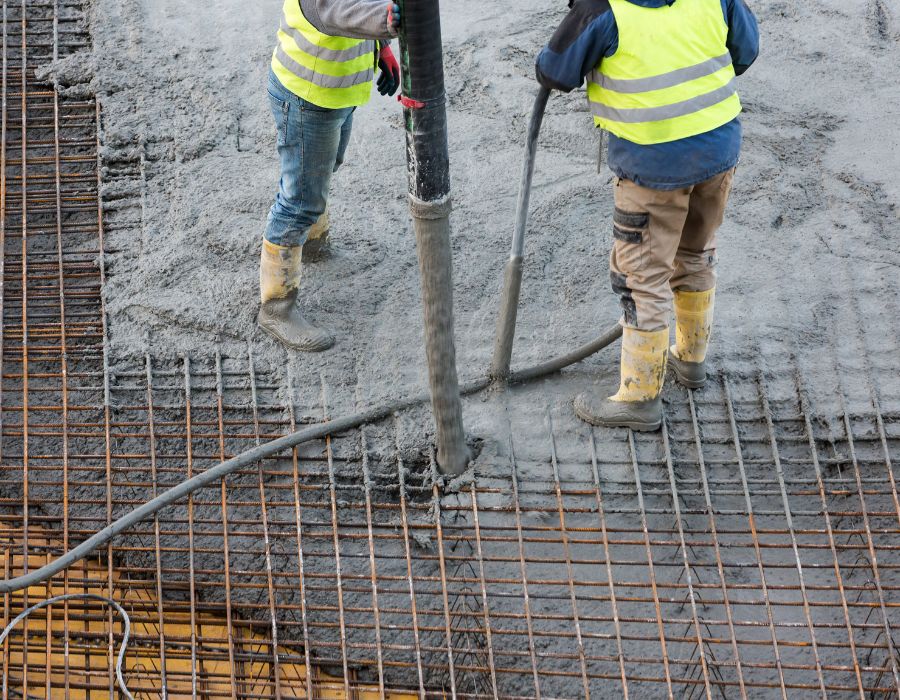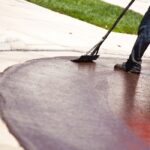Concrete is one of the most versatile materials for home aesthetics improvement, and when it comes to enhancing your property’s aesthetics, two popular decorative concrete finishes stand out: concrete stamping and staining. Homeowners in San Antonio looking to upgrade their patios, driveways, or walkways often face the dilemma of choosing between these two options. This article will compare concrete stamping vs. staining, discussing their benefits, costs, maintenance requirements, and customization options to help you make an informed decision.
Understanding Concrete Stamping and Staining
What is Stamped Concrete?
Stamped concrete is a decorative technique where freshly poured concrete is imprinted with textured patterns that mimic materials like stone, brick, or wood. The process involves pressing molds into the wet concrete before it sets, followed by adding color through integral color mixtures or surface-applied stains. Stamped concrete is often used for patios, driveways, pool decks, and walkways, providing an elegant and durable surface that enhances curb appeal.
What is Stained Concrete?
Stained concrete involves applying chemical or water-based stains to existing concrete surfaces, allowing for a wide variety of colors and artistic designs. Unlike stamped concrete, which alters the texture, staining primarily enhances the color and depth of the surface while maintaining its original smoothness. Acid-based stains create unique, variegated tones by reacting chemically with the concrete, while water-based stains offer more uniform and vibrant hues.
Stamped Concrete Benefits
1. Aesthetic Appeal & Versatility
Stamped concrete provides a luxurious appearance that can mimic high-end materials such as flagstone, slate, and cobblestone at a fraction of the cost. Homeowners can choose from numerous patterns and textures to complement their home’s exterior, making it a great choice for enhancing curb appeal.
Another advantage is the ability to create customized designs, including decorative borders, medallions, or intricate geometric patterns. This makes stamped concrete ideal for homeowners who want a truly unique and personalized outdoor space.
2. Durability & Longevity
When properly installed and sealed, stamped concrete is highly durable and can last 20 to 30 years with minimal wear and tear. It withstands heavy foot traffic, vehicle loads, and extreme weather conditions, making it a reliable option for outdoor surfaces.
Additionally, stamped concrete is resistant to weeds and pests, unlike traditional pavers, which can shift over time and create gaps where unwanted growth can occur. This makes it an excellent long-term investment.
3. Slip-Resistance & Safety
Stamped concrete can be treated with anti-slip additives, making it a safer option for outdoor surfaces such as pool decks and patios. Textured finishes improve traction, reducing the risk of slips and falls even when the surface is wet.
4. Increased Property Value
Because of its high-end aesthetic and long lifespan, stamped concrete can boost the resale value of your home, making it an excellent investment. Potential buyers are often drawn to beautifully designed outdoor spaces, which can make your property more attractive in the real estate market.
Stained Concrete Advantages
1. Vibrant Color Variety & Customization
Stained concrete offers an extensive range of colors and custom artistic designs, allowing homeowners to achieve unique and personalized looks. You can choose earthy tones, bold hues, or even translucent effects for a modern touch. The ability to layer colors and use stencils also allows for more artistic and intricate designs, such as faux finishes that resemble marble or natural stone.
2. Budget-Friendly for Large Surfaces
Compared to stamped concrete, staining is a more affordable option, especially for large outdoor areas such as driveways and patios. It requires fewer materials and less labor-intensive work, making it ideal for homeowners looking to enhance their property’s appearance without breaking the bank.
Additionally, stained concrete can be applied to existing concrete surfaces, reducing the need for complete demolition and replacement, which can further lower costs.
3. Easy Maintenance Requirements
Stained concrete is relatively low-maintenance. Regular cleaning and periodic resealing can keep it looking vibrant for 15 to 25 years. Since stains penetrate deeply into the concrete surface, they are less likely to fade or peel over time compared to surface coatings.
4. Smooth Surface Texture
Unlike stamped concrete, which has grooves and patterns, stained concrete retains its smooth texture, making it an ideal choice for indoor applications or areas where easy cleaning is a priority. This can be particularly beneficial for homeowners who want a polished and contemporary look without added texture.
Cost Differences: Stamped vs. Stained Concrete
The cost of concrete stamping and staining varies based on factors such as square footage, design complexity, and labor fees. Here’s a rough estimate for San Antonio homeowners:
- Stamped Concrete: $10 to $25 per square foot (depending on complexity)
- Stained Concrete: $3 to $10 per square foot (depending on stain type and design)
For large surfaces like driveways, staining is the more budget-friendly option, while stamped concrete offers a more sophisticated, high-end look at a higher cost.
Maintenance Requirements: Which Option Lasts Longer?
Both options require maintenance, but the level of upkeep varies:
- Stamped Concrete: Requires resealing every 2–3 years to maintain texture and prevent cracks. Cleaning with mild soap and water is recommended.
- Stained Concrete: Needs resealing every 3–5 years, but it doesn’t require frequent touch-ups since the color penetrates deeply into the concrete.
To extend the lifespan of either option, homeowners should avoid using harsh chemicals, regularly sweep debris, and apply a protective sealer as needed.
FAQs
1. How do stamped and stained concrete differ in terms of maintenance?
Stamped concrete requires more frequent resealing and crack repairs, while stained concrete is easier to maintain due to its smooth surface and long-lasting color penetration.
2. Which option is more budget-friendly for large outdoor areas?
Stained concrete is typically the cheaper option, making it ideal for large areas like driveways or commercial spaces. Stamped concrete, while more expensive, provides a high-end finish that may be worth the investment.
3. Can I customize the color and pattern of both stamped and stained concrete?
Yes! Stamped concrete allows customization in both texture and color, while stained concrete offers a wider range of color customization with artistic finishes. However, if you want a textured surface, stamped concrete is the better choice.
4. What is the average lifespan of stamped vs. stained concrete?
Stamped concrete lasts 20–30 years with proper care, while stained concrete can last 15–25 years before requiring refinishing.
Final Verdict: Which is Best for Your San Antonio Home?
Choosing between concrete stamping vs. staining depends on your budget, design preference, and maintenance expectations:
- Go with stamped concrete if you want a high-end, textured look that mimics natural materials and are willing to invest in maintenance.
- Choose stained concrete if you’re looking for a cost-effective, colorful, and low-maintenance solution, especially for large areas.
Both decorative concrete finishes can enhance the beauty and functionality of your San Antonio home—select the one that best fits your needs and lifestyle!







